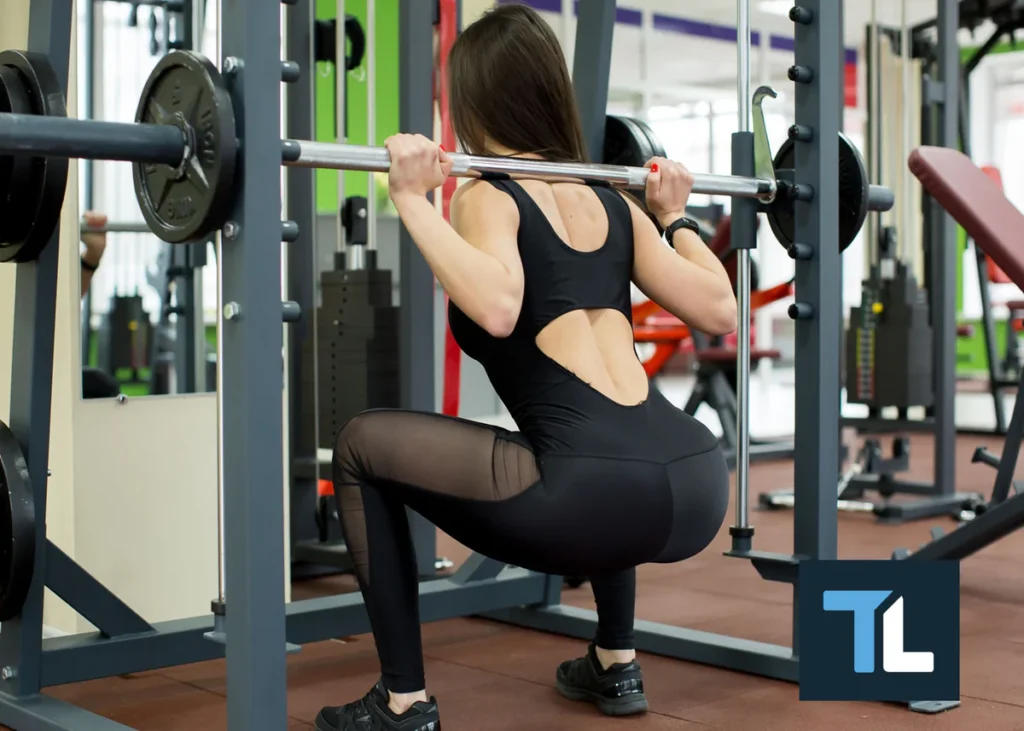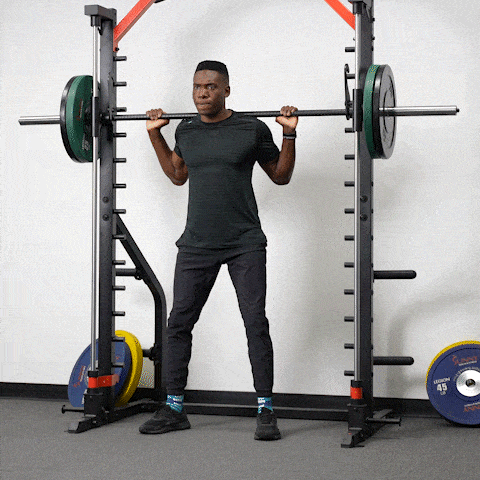The Smith machine squat is a popular exercise for targeting the lower body, particularly the quadriceps, glutes, and hamstrings. This machine-guided movement provides stability and support, making it suitable for beginners and experienced lifters alike. In this detailed guide, we’ll walk you through everything you need to know about performing the Smith machine squat, including its benefits, proper form, variations, common mistakes, and how to incorporate it into your leg workout routine. Without further ado, let’s delve into it.

Understanding the Smith Machine Squat
The Smith machine squat is a variation of the traditional barbell squat, where you use a Smith machine instead of a free-weight barbell. The Smith machine consists of a barbell attached to vertical rails, allowing for controlled movement along a fixed path. This guided motion provides stability and support, making it an ideal option for individuals who are new to weightlifting or those who want to focus on perfecting their form.
Benefits of the Smith Machine Squat
Stability
The guided movement of the Smith machine squat helps to stabilize the weight, allowing you to focus on proper form and technique without the need for a spotter. This makes it an excellent option for beginners or individuals with limited experience in weightlifting.
Safety
The Smith machine provides a built-in safety mechanism, with the barbell locked into place along a fixed path. This reduces the risk of injury by preventing the barbell from tipping or rolling during the exercise.
Muscle Activation
The Smith machine squat targets the quadriceps, glutes, hamstrings, and calves while also engaging stabilizing muscles in the core and lower back. This provides a comprehensive lower body workout and helps to improve overall strength and muscle development. Matter of fact, it’s one of the best leg exercises especially for quads and hams.
Progressive Overload
The Smith machine allows for easy adjustment of resistance levels, making it suitable for progressive overload training and strength progression over time. This allows you to gradually increase the weight as you become stronger and more experienced.
Versatility
The Smith machine squat can be performed with various foot positions and stances, allowing for versatility in training and targeting different areas of the lower body.
Also Read: Smith Machine Shoulder Press: How-to, Variations & More!
How to Perform the Smith Machine Squat
Setup
Position yourself underneath the Smith machine barbell, with the bar resting on your traps or upper back. Adjust the height of the barbell so that it is within easy reach when standing.
Stance
Stand with your feet shoulder-width apart or slightly wider and your toes should be pointed slightly outward. Keep your chest up and lifted, back straight, and core engaged throughout the movement.
Execution
Lower your body downwards by bending your knees and hips, keeping your back straight and chest lifted. Descend until your thighs are parallel to the ground or slightly below, ensuring that your knees do not extend beyond your toes.

Breathing
Inhale as you lower your body downwards, and exhale as you push through your heels to return to the starting position. Focus on maintaining a steady and controlled breathing pattern throughout the exercise.
Range of Motion
Aim for a full range of motion by lowering your body until your thighs are parallel to the ground or slightly below. Avoid bouncing at the bottom of the movement and focus on maintaining tension in the muscles throughout the exercise.
Repetition
Complete the desired number of repetitions with proper form and technique. Aim for 8-12 repetitions per set, adjusting the weight as needed to challenge your muscles while maintaining good form.
Cooldown
Once you’ve completed your sets, carefully rack the barbell and take a moment to stretch your lower body to promote recovery and flexibility.
Incorporating the Smith Machine Squat into Your Routine
As we already know, this version of squat can be incorporated into your lower body training routine to target the quadriceps, glutes, hamstrings, and calves. Aim to include the Smith machine squat as part of a comprehensive leg workout program that targets all major muscle groups of the lower body, including the quadriceps, hamstrings, glutes, and calves.
Depending upon your workout split, perform the Smith machine squat 1 or 2 times per week, with 3-4 sets of 8-12 repetitions per session in your leg day(s). Start with a light weight to warm up the muscles and gradually increase the weight as you become more comfortable with the movement.
In addition to the Smith machine squat, include a variety of other lower body exercises such as leg presses, hack squats, Bulgarian Split Squats, leg extensions, leg curls etc. to target different areas of the lower body and ensure balanced muscle development.
Common Mistakes to Avoid
Knees Extending Beyond Toes
Avoid allowing your knees to extend beyond your toes during the squat movement, as this can place excessive stress on the knee joints and increase the risk of injury. Focus on sitting back and down, keeping your weight on your heels.
Rounding the Lower Back
Avoid rounding or arching your lower back during the squat movement, as this can strain the lower back and increase the risk of back injury. Keep your back straight and chest up throughout the exercise.
Not Using a Full Range of Motion
Aim for a full range of motion by lowering your body until your thighs are parallel to the ground or slightly below. Avoid cutting the range of motion short, as this limits the muscle activation and growth.
Using Excessive Weight
Choose a weight that should be perfect for you to perform the exercise with proper form and technique for at least 8 to maximum 12 repetitions. Although, smith machine is safer than traditional barbell squat, using excessively heavy weights can still compromise your form and increase the risk of injury.
Not Engaging the Core
Keep your core muscles engaged throughout the exercise to stabilize your spine and maintain proper alignment. Avoid letting your core muscles relax or sagging your torso forward.
Variations of the Smith Machine Squat
Narrow Stance Squat
Perform the Smith machine squat with your feet closer together to target the inner thighs and quadriceps to a greater extent. Since it’s an advanced version of the traditional machine squat, one shouldn’t do this without mastering the form of the basic one first.
Wide Stance Squat
Perform the Smith machine squat with your feet wider apart to target the outer thighs, glutes, and hamstrings more effectively. While narrow stance is harder than the traditional one, wide stance is somewhat easier which is why, it needs heavier weight to give maximum muscle activation.
Conclusion
The Smith machine squat is one of the most effective exercise for targeting the lower body muscles, including the quadriceps, glutes, hamstrings, and calves. By mastering proper form and technique, avoiding common mistakes, and incorporating variations into your routine, you can maximize the benefits of this exercise and achieve your fitness goals safely and effectively. Whether you’re a beginner or an experienced lifter, the Smith machine squat offers an outstanding addition to your lower body training arsenal for building strength, power, and muscle mass in your lower body. Hopefully, you found this article helpful enough. If you really did then let us know your valuable unfiltered thoughts in the comment section down below. Thanks for visiting and appreciating our work.
